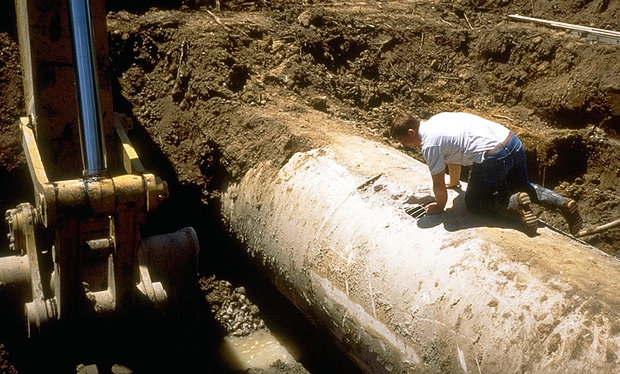With the state’s debilitating collapse of reliable infrastructure placed on center stage Monday by a Gov. Rick Snyder study commission, construction contractors will announce today an aggressive campaign to convince Michigan taxpayers that a long-term, high-priced effort to fix roads, bridges and sewer/water pipes must be undertaken to avoid catastrophic consequences.
The initiative, dubbed FixMIState, advocates a multi-billion dollar project to improve basic infrastructure-related services from Marquette to Monroe. The plan emerged from the Michigan Infrastructure and Transportation Association, an advocacy group for construction firms working on public-sector projects.
While MITA has a financial interest in increased construction projects, the group has become increasingly frustrated, dating back to 2005, in its efforts to explain to the public, politicians and the media that Michigan has fallen dramatically behind in maintaining an overall infrastructure network that is free of potholes, road detours, crumbling bridges, flooded streets and freeways, water main breaks and sinkholes, and the dumping of sewage overflows into the waterways.
Though experts have pointed out that Michigan has some crumbling infrastructure that is 50 to 100 years old, officials at the state and local level largely have pushed the warnings aside during the so-called “lost decade” of economic stagnation in the 2000s, especially during the Great Recession of 2008-10, and into the recovery period of 2010-14. The result is that Michigan’s infrastructure is ranked among the worst in the nation.
A key focus will be on failing equipment and piping that leads to water pollution incidents in Michigan lakes, rivers and streams. FixMIState piggybacks on a first-of-its-kind report by Snyder’s 21st Century Infrastructure Commission in which Michigan became the first state in the nation to assess and prioritize its infrastructure needs.
The accompanying, ambitious PR effort will not necessarily push for an all-infrastructure, all-the-time approach to the Legislature’s machinations in Lansing. But the goal is pretty close to that kind of paradigm shift in state politics.
Social media, TV, radio will push the message
The long-running lobbying campaign initially will rely upon email messages to state legislators, social media, especially Facebook, online advertising, and coalition-building to put the infrastructure issue front and center. The campaign is based on years of research including a survey and focus groups with voters across Michigan, a close review of reports, studies and other data that have sought to quantify and monitor the state’s unmet infrastructure needs and problems, and news media stories about failing infrastructure.
A campaign website, FixMIState.org, is already up and running. TV and radio advertising will eventually fall into place as FixMIState pushes for action in the Legislature or a statewide ballot proposal or a number of local revenue-raising proposals across the state. While not revealing any dollar amounts, MITA executive director Mike Nystrom said the association will commit 15 to 20 percent of its annual budget to the “education project” for the foreseeable future.
“I think this continues the conversation,” Nystrom said. “What we learned from the (2015) road funding debate is that it takes time for the public to fully understand infrastructure … and why it’s important to people in their daily lives.”
That was a reference to the 2015 road funding plan approved in the state House and Senate, and signed into law by Snyder, which established modest increases in vehicle registration fees and fuel taxes, plus shifts in state budget appropriations, to gradually improve certain roads and highways.
That scaled-down plan served as a toe-dip into the deep waters of the state’s potential infrastructure calamity over the next few decades. “Even with these investments,” the state should be spending an additional $2.2 billion a year if it hopes to keep a majority of its roads and bridges in good shape, according to the report.
In addition, the campaign will point out dangers involved with failing to address unseen underground infrastructure that can lead to pollution and public health problems on a disturbing scale.
The Infrastructure Commission’s 188-page report said: “The Flint water crisis has placed a national spotlight on the impacts of deteriorating infrastructure, declining population and system usage, fragmented decision making, and severe underinvestment in critical water infrastructure.”
100-year-old underground water systems
Many of Michigan’s water systems were built 50 to 100 years ago, according to the report, leading to this reality: an average of 5.7 billion gallons of untreated or partially treated sewage discharged into Michigan’s waterways annually since 2008; at least 1,200 bridges in the state structurally deficient or obsolete; and 38 percent of the state’s roads in poor condition.
Based on previous reports by the Southeast Michigan Council of Governments (SEMCOG) about the stunning lack of repairs and upgrades to declining sewer and water pipes and equipment in the state’s most populous area, the $4 billion yearly estimate of Michigan’s overall infrastructure needs could well be short of the mark. Contaminated water spills and leakage have been reported recently from Troy to Ann Arbor to Kalamazoo to Oscoda.
Among the nonprofit organizations that may join the FixMIState coalition is Macomb County-based Save Lake St. Clair, a relatively new environmental organization that has shined a light on the impact of hundreds of millions of gallons of sewage overflows and hundreds of beach closings along the lake in recent years and over the past two decades. Outdated infrastructure is largely to blame for these disturbing summertime pollution outbreaks.
The state Infrastructure Commission takes a broad view, analyzing the state’s shortfalls in providing quality water, roads, rail service, commercial shipping facilities and energy supplies. The report also recommends that Michigan take steps to become a “top-five state for broadband access.” Quality Internet access is an especially troublesome issue facing much of the Upper Peninsula.
Beyond that, the commission makes the case that infrastructure issues in Michigan are separated in bureaucratic “silos” that represent a dizzying, decentralized approach to problems faced in every corner of the state. The current status: 619 separate road agencies, 79 transit agencies, 1,390 drinking water systems, 1,080 wastewater systems, 116 electric utilities, 10 natural gas utilities and 43 broadband providers.
Incredibly, no data has been compiled that can fully detail the state’s infrastructure inventory and its failings across the state on a county-by-county basis. The recommended creation of a Michigan Infrastructure Council would serve as a data collection point and would establish a statewide strategy by 2018, based on an initial pilot program of infrastructure project planning in one specific region of the state.
Funding from the federal government, plus locally financed projects at the municipal level and broad public-private partnerships with business and industry could help get Michigan out of the hole.
Daunting price tag cannot be ignored
Yet, the $4 billion annual price tag is so daunting that it represents an unprecedented boost in government spending compared to the overall state general fund budget, which is financed by $10 billion in revenues.
In fact, the Infrastructure Commission study concedes that numerous increases in taxes and fees to finance the effort would still fall short. For example, nearly $3.4 billion could be raised – not $4 billion –if lawmakers and voters approved this particular funding combination: a 1 percentage point increase in the state sales tax, a 1-mill property tax levy statewide, a 10-cent-per-gallon increase in the state gas tax, the creation of a separate 10-cent gas tax in each county, a 20 percent increase in vehicle registration fees, a $1.54 surcharge on monthly bills for Internet service, and a dedicated water user fee of $1 per 10,000 gallons used.
Individually, none of those options raises enough money to fund half of the state’s projected infrastructure needs, and most cover less than 10 percent.
What’s more, Detroit Water and Sewerage Department Director Gary Brown threw an additional hurdle in the path of the FixMIState campaign when he said Monday that DWSD customers, though the city has massive sewer/water infrastructure problems, should not be expected to contribute much to the statewide effort. “This should not be put on the backs of residents with such a high poverty rate,” Brown said.
Nystrom, of MITA, said the bottom line is that catching up with infrastructure needs will require going beyond standard user fee-style payment plans, such as gas taxes and water/sewer rates. At the same time, any plan must deal with the fact that low-income residents in aging urban neighborhoods, especially in places like Detroit and Flint, cannot afford the price tag of a massive improvement plan.
“Ironically,” Nystrom said, “those who can least afford to pay for this are the most in need of infrastructure improvements.”
Photo: SEMCOG, via Wayne County





